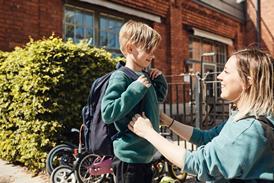For a free pdf download of this resource click here
Toppling pyramids
Where: indoors
Space needed: about 6m by 3m
Number of children: 2+
Equipment: cups, two benches or tables, plastic ‘ball pond’ balls
Now this is a rare gem: an action game that can be played with two or 20 kids. So if you run a small group you’re in for a treat. Take two benches (or low tables) and place them about two metres apart. Behind each bench place two chairs about a metre apart, in the middle of each bench. The section between the chairs on the bench is the build area. Now split the kids into two teams. Each team is given 100 plastic cups and they have two minutes to build as solid and high a pyramid as possible in the build area of their bench. The rules for the build are that all cups must be on the bench between the two chairs, each level of the pyramid must be no more than three cups wide and you can’t ‘double-stack’ cups. Collect in the spare cups and get the children to go behind the bench on the outside of the chairs (i.e. not directly behind the pyramid).
The aim of the game is, as you might have guessed, to knock down the opposing team’s pyramid. I’ve found that the best projectiles to use are ball pond balls. They strike the right balance between being strong enough to knock over a plastic cup but not too painful if they hit you. Give each team a pile of balls and when you say ‘Go!’ both teams throw together to try and knock down the other team’s pyramid. They will have two minutes to try and knock down every cup in the other team’s structure. It’s important that all the kids stay behind the bench
and outside the chairs so they are less likely to be hit with a flying ball.
The winning team is the one that completely knocks down the other’s pyramid or, if neither team manages that, the one that has the most cups still standing at the end of the two minutes. It’s quite a quick game so you can easily play two or three rounds at one time. And at the end I always offer points for the first team to collect all their cups and balls in to help with the clearing up!
Samson, Delilah and the lion
Where: indoors or outdoors
Space needed: lots of space to run in
Number of children: 6+
Equipment: none
This is an active twist on the classic rock, scissors, paper game. The actions for each person or animal are: Samson – flexing muscles, Delilah – hand on hip while beckoning and lion – showing claws and teeth. (I like to throw a noise in with the action as well but I’ll leave that up to you.) Samson kills the lion, the lion can eat Delilah and Delilah captures Samson.
Now split the children into two teams and send the two teams to the opposite ends of the hall. Each team needs to decide which of the three actions they are going to do. Everyone on the team needs to do the same action! When both teams have decided on an action the teams get in a line and march slowly towards each other. They stop about two metres apart and the referee then counts down from three before they do their action.
If one team’s action beats the other team’s, then the losing team has to run back to their side and safety while the winning team has to try and catch them before they get there. If anyone on the losing team is caught before reaching safety they join the winning team. (You might need to point out which team has won until the kids, and leaders, get the hang of the game.) If both teams do the same action it’s a draw and both walk back to their side and try again. You can repeat this as many times as you wish and at the end the winning team is the one with the most people on it.
Simple Game: Heads down, thumbs up
Where: indoors
Space needed: enough to sit in
Number of children: 8+
Equipment: none
This is another one of those that I don’t really ‘get’ but the kids love, and is especially popular with the younger kids in our group.
You begin by choosing four people to be catchers. They stand at one end of the hall. Then you get every other kid to sit down (you can sit at the table or on the floor), close their eyes, put their head down and their two thumbs up. Make sure no-one is peeking during this bit otherwise it spoils the game. The four catchers then walk around the other kids and each touches the thumb of one child (make sure it’s only one child and no more). If a child’s thumbs are touched they fold their thumbs down so you can see who has been tagged. When all four catchers have tagged someone they go stand at one end of the hall then everyone can look up. Those who were tagged stand and they have to guess who tagged them. They get only one guess and if they’re right they swap places with the catcher but if they’re wrong they stay where they are.
And that’s it! It sounds ridiculous but if you’ve got some younger children in your group give it a go, they’ll love it! Make sure that the catchers spread the tags around and don’t just choose their friends.






































